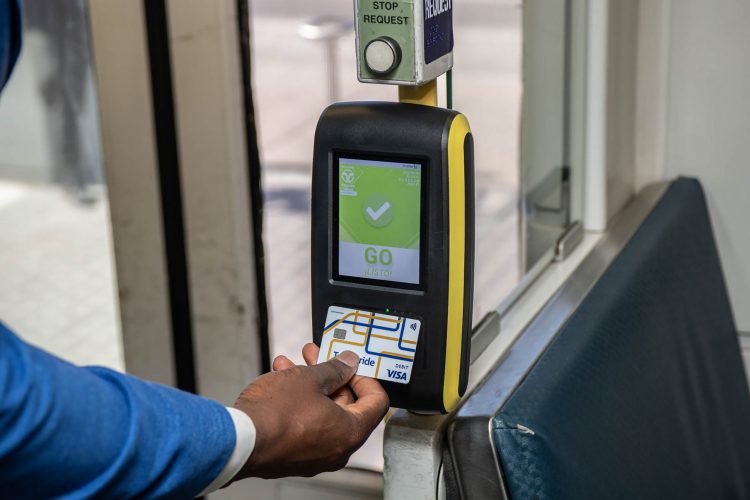California taps into the future of fare collection
 California taps into the future of fare collectionGillian Gillett, Program Manager of California Integrated Mobility at the California Department of Transportation, outlines the agency’s vision for a connected transportation network in California, which will offer riders contactless payments and better journey information.
California taps into the future of fare collectionGillian Gillett, Program Manager of California Integrated Mobility at the California Department of Transportation, outlines the agency’s vision for a connected transportation network in California, which will offer riders contactless payments and better journey information.
The phrase “transportation in California” likely evokes images of vast tangles of freeway, the crimson contours of brake lights threading from desert to ocean. It’s true, the car is king in California. Cars account for more than eight out of 10 of the state’s commutes, while solo drivers make up three out of four. The result? Poor air quality, mind-numbing traffic and inadequate ways for carless Californians to get around.
Within this context, California has set ambitious objectives for sustainability, mobility and equity, and has positioned public transit as the cornerstone of its agenda to achieve these targets. But getting car-reliant Californians to park their cars and board a bus is no mean feat.
That’s why the California Department of Transportation (Caltrans) is trying a new approach to transit planning: think less like government and more like tech, and design transit that works for everyone.
To get there, in 2019, Caltrans hatched the California Integrated Travel Project (Cal-ITP), the state’s new incubator for mobility innovation. As a team of veterans from the technology and transportation industries, Cal-ITP is working with transit providers across the state to make riding transit an easy, intuitive and predictable experience that puts riders at the heart of transit planning.
To kick things off, we conducted a market sounding with a broad cross section of industry representatives for input on how California should improve the rider experience and increase transit’s mode share. Rather than the usual response from a handful of speciality vendors, the kickoff event saw front row seats occupied by heavy hitters from the payments and mobility industries, including PayPal, Visa, Mastercard, Google and Uber. Here’s what we learned:
California’s 300+ transit providers build and plan in silos. This lack of standardisation makes it impossible to invest in solutions that scale, resulting in bespoke systems that are not interoperable for either providers or riders
Innovation and standardisation in the banking and payments industries mean that legacy transit fare systems will not compete well.
The solution: unify transit across California with a single, interoperable payment system and real‑time data standard to make transit easier to use and more appealing to both new and regular riders. Specifically, Cal-ITP is crisscrossing the state to achieve the following three objectives:
Enable open-loop contactless payments: adopt the global contactless Europay, Mastercard, Visa (cEMV) standard as the state’s primary fare payment technology so that riders can quickly and easily tap to pay using their smartphone or the bank card that’s already in their wallet.
Automate customer discounts: streamline the process for riders to instantly qualify for and receive transit discounts (ie senior, veteran, student) when they tap to pay, regardless of which transit system in the state they use.
Standardise information for easy trip planning: remove the guesswork for riders wondering when the next bus or train will arrive by using the General Transit Feed Specification Realtime (GTFS-RT), the global standard for publishing real-time transit information, including fares and payment methods.
Creating a marketplace
When it comes to interoperability in transit, conceiving a system and building it are two entirely different matters. It’s essential that we make it as easy and affordable as possible for all transit providers – regardless of their budget or staff capacity – to procure the technologies that they’ll need. To that end, Cal-ITP has developed the California Mobility Marketplace1, an online catalogue of code-compliant products and services that transit providers will need in order to start using contactless fare collection and real-time GTFS data.
Cal-ITP is working with transit providers across the state to make riding transit an easy, intuitive and predictable experience”
The Mobility Marketplace takes an innovative approach to public procurement. Rather than having individual transit providers fend for themselves on the open marketplace to find the right technologies, it gathers and presents links to a suite of pre-negotiated, code-compliant products and services. This means that nearly all of the procurement work has already been done. For each product and service, Caltrans has already identified or advanced an RFP and leveraged the purchasing power of the State of California to negotiate deeply discounted rates with the selected vendors. All transit providers need to do is choose which products and services work best for them and sign on to existing contracts. This approach saves providers time and money and enables any agency, even those with little to no procurement experience, to design and purchase their own fare collection systems.
https://www.civilengineering.ai/california-taps-into-the-future-of-fare-collection/

Post a Comment